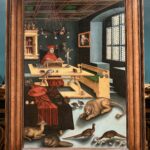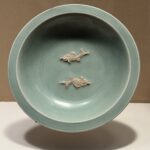The John and Mable Ringling Museum of Art

5401 Bay Shore Rd,
Sarasota, FL 34243
Dim Sum Kitchen & Oak & Stone.
… more pix and video in Google Maps
Will return: a small museum with a huge collection. It shares the parking lot with Sarasota Ballet.
On the Sarasota Bay, this is a good and manageable museum/gallery, which I don’t feel guilty for not walking 100 miles to cover portion of it -:). It’s a little surprise to see their vast and high quality exhibits, from ancient to contemporary. Not too shabby, compares to the oil and railroad barons, it sure gave them a good run for their money.
Larger part of the ground is closed at the moment, due to two recent hurricanes: Helene and Milton.
It was the home to Mable Burton (1875-1929) and John Ringling (1866-1936), of the Ringling Bro traveling circus fame. They were married in 1905, no children.
I’ve taken my kids to Ringling Bro and Big Apple at the Lincoln Center. But now to think of it, both are dated. Cirque du Soleil (1984-) seems to be the one to go to. So is the cycle or circle of life.
 Among so many exhibits, (paintings, photographs, modern arts, …) I found Peter Paul Rubens (1577-1640) five large oil paintings by his workshop the most impressive.
Among so many exhibits, (paintings, photographs, modern arts, …) I found Peter Paul Rubens (1577-1640) five large oil paintings by his workshop the most impressive.
The Triumph of the Eucharist by Peter Paul Rubens
These galleries feature five immense oil paintings by the Flemish artist Peter Paul Rubens (1577-1640) and his workshop. The paintings reproduce a series of tapestries on the theme of the Triumph of the Eucharist that Rubens designed at the request of his patron, Isabella Clara Eugenia (1566- 1633), the ruler of the Spanish Netherlands. Isabella commissioned the tapestry cycle in 1625 for a convent near Madrid, Spain, known as the Descalzas Reales, which held special importance for her and her family (the original tapestry cycle is still preserved there). Why Rubens and his workshop also reproduced some of the tapestries at full-scale in oil on canvas-highly unusual for the time-is not entirely clear, but it is thought that Isabella may have wanted the paintings for her palace in Brussels, as a way of remembering her beloved convent from afar.
John Ringling purchased four of the canvases now in Gallery 2 from the Duke of Westminster in 1926, while the canvas on view in Gallery 1 was purchased by the museum in 1980. Gallery 1 also displays a 17th-century tapestry woven after one of Rubens’s designs for the series.
We got to visit the glass exhibit and the main hall/house. This orchid on bamboo, titled Paphiopedilum Bamboo is by Debora Moore (1960-), done in 2002. The painting grabbed me, but has no plaque to know more about it. It’s displayed in the man cave room, a coupe of room down from the Rubens’.
The green boxy structure – Ting Tsung and Wei Fong Chao Center for Asian Art, (趙廷箴/赵廷箴 1921-2008; a petrochemical & plastic industrialist, born in Suzhou, went to Taiwan before 1949 …) is eye-catching but contained very little interesting exhibits.
Dish w/ Two Unglazed Carp was from Southern Song, (12th-13th centuries). It was a gift from Ira and Nancy Koger in 2001.
Bowl with Silver Mount and Handles
Chinese body, late 16th-c. style, and European mount,
19th c.
Porcelain, gold washed mounted in Europe
This piece is a blue-and-white bowl with a lobed rim placed in a double-handled silver mount. The European practice of mounting oriental porcelain has a long history, but was particularly prominent in the eighteenth century as part of the interest in Chinese objects in France.
Gift of Ira and Nancy Koger, 2001, SN11122.60
Iznik Plate with Grape Vine Decoration Turkey, Mid 16th c.
Loaned by John Hobart Wentworth h in memory of his grandfather Richard Brvant Hobart, IL2016 29.5
Off the main hall (ticket & restaurant), is the glass exhibit.
- Enduring Light, black and white pix by Roy DeCarava and Danny Lyon about 1960s civil rights movement.
- Jess T. Dugan: I want you to know my story, learning one’s identity
- Shinique Smith: Parade sculptures made with old cloths
- The Greatest Show on Earth: probably the few permanent exhibit.





